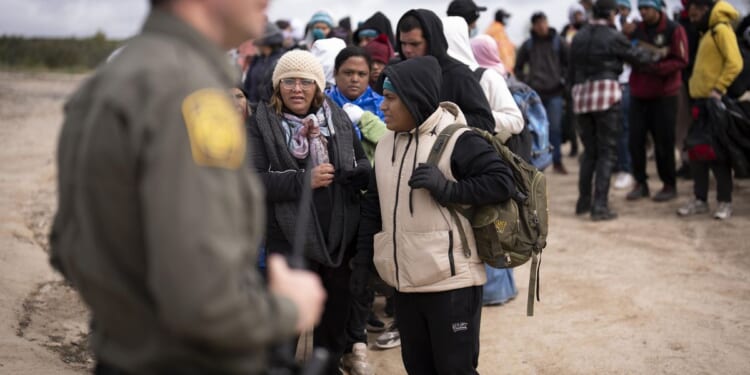
President Biden has overseen the fastest expansion of immigration — legal and illegal — in history, but less than half of the newcomers are holding jobs, according to a new report released Monday.
The Center for Immigration Studies, using Census Bureau numbers, calculates that 46% of the immigrants who arrived over the last two years are employed. That challenges a key selling point from immigration advocates that the stream of newcomers is critical to the U.S. economy.
Some of the immigrants say they are looking for work, but most are out of the labor force entirely, including the elderly, children and caregivers, the report said.
“Immigration clearly adds workers to the country, but it just as clearly adds non-workers who need to be supported by the labor of others,” said report authors Steven A. Camarota and Karen Zeigler. “Those who simply see immigration as a source of labor need to understand it is also a source of school children, retirees, and many other non-workers. How could it be otherwise; immigrants are people.”
The U.S. had 51.6 million immigrants as of March 2024 which is up 5.1 million since March 2022. That’s the largest two-year increase in history. Going back to the start of the Biden administration, the country has netted 6.6 million foreign-born.
Immigrants account for 15.6% of the country’s total population, which is also a record, shattering the previous high of 14.8% in 1890.
CIS said if current trends continue the U.S. will top 18% by the end of this decade. Australia’s population is 30% immigrants and Canada’s population is more than 20%, while Germany is roughly 19%. The U.K. is 14%.
“Perhaps the most fundamental question these numbers raise is whether America can successfully incorporate and assimilate all the immigrants already here, let alone millions more in the future,” the report said.
One persistent issue has been the question of whether immigrants are a net benefit or drain.
The Congressional Budget Office says that taken as a whole, the economy grows faster with more people. The reason is simple: More potential workers means a more productive total economy.
But the CBO also says the average worker is slightly worse off, and again the reason is simple: The pie may be bigger, but it is divided by even more people.
The CBO says that within the population, there is a large range of outcomes, with those at the higher economic rungs coming out better off with higher immigration levels, while those on the lower rungs, who are more likely to compete with less-educated newcomers, end up worse off.
That dynamic is particularly true in times of high illegal immigration because those new arrivals tend to be less educated.
The CIS said among non-college-educated immigrants from Latin America — a population that overlaps heavily with illegal immigrants — the unemployment rate is 10%, which has held steady for several decades.
There has been a major push by the Biden administration to try to get official work permits into the hands of newly arrived illegal immigrants who are caught and released into the interior. Immigrant rights advocates say that will allow the migrants to support themselves and stop using government assistance.
Mr. Camarota and Ms. Zeigler said illegal immigrants seem to be getting jobs whether they have legal permits or not.
“Worksite enforcement in the United States is quite lax,” they wrote. “As best we can tell, lack of work authorization does not seem to be a significant hindrance to the employment of illegal immigrants relative to the past or compared to immigrants overall.”
The CIS based its report on the Census Bureau‘s Current Population Survey, the same monthly tool the government uses to tally the unemployment rate.
The CIS said the numbers pertaining to immigrants are, if anything, undercounting the situation since immigrants can be somewhat resistant to answering government survey questions.












